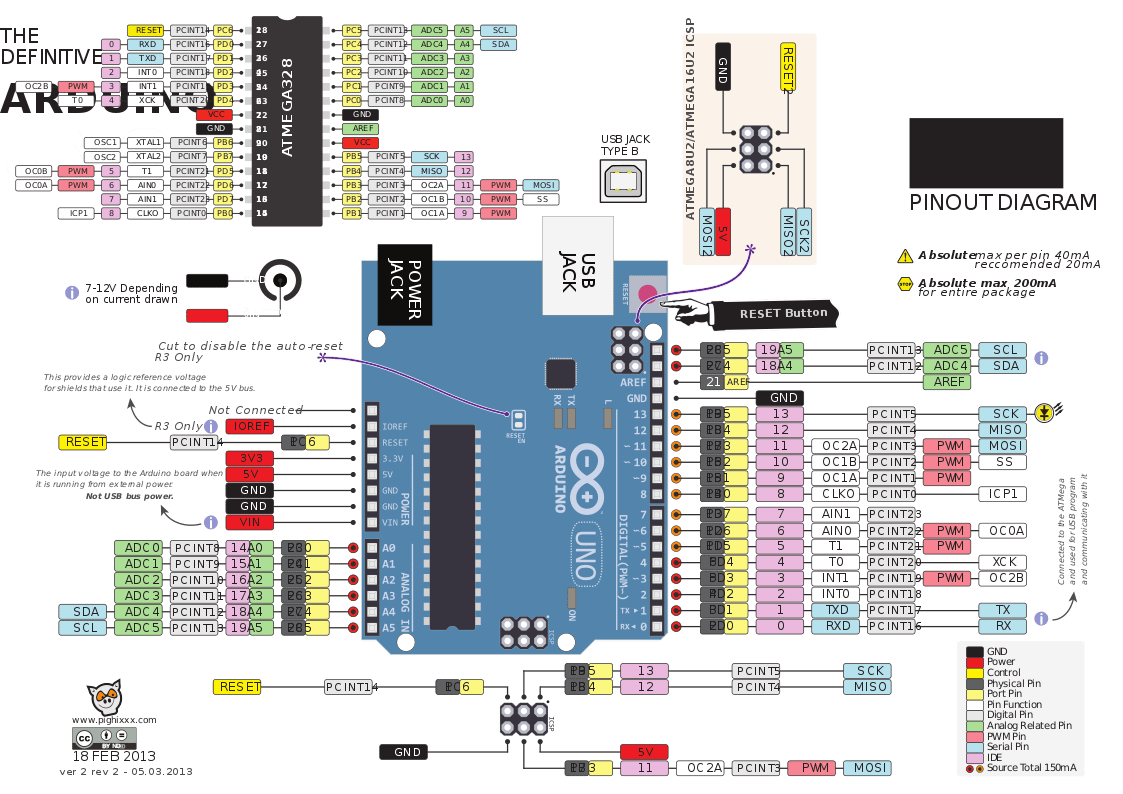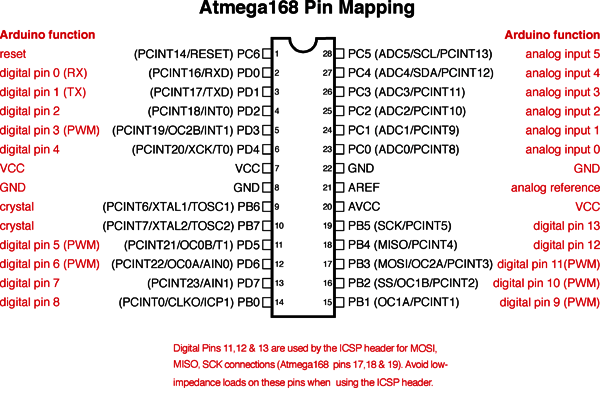Arduino Uno Pinout
Specifications
| Microcontroller | ATmega328P |
| Operating Voltage | 5V |
| Input Voltage (recommended) | 7-12V |
| Input Voltage (limit) | 6-20V |
| Digital I/O Pins | 14 (of which 6 provide PWM output) |
| PWM Digital I/O Pins | 6 |
| Analog Input Pins | 6 |
| DC Current per I/O Pin | 20 mA |
| DC Current for 3.3V Pin | 50 mA |
| Flash Memory | 32 KB (ATmega328P) of which 0.5 KB used by bootloader |
| SRAM | 2 KB (ATmega328P) |
| EEPROM | 1 KB (ATmega328P) |
| Clock Speed | 16 MHz |
| LED_BUILTIN | 13 |
| Length | 68.6 mm |
| Width | 53.4 mm |
| Weight | 25 g |
Arduino Uno Pinout
Arduino UNO Pinout Description
| Category | Name | Details |
| Power | Vin, 3.3V, 5V, GND | Vin: Input voltage to the Arduino when using an external power source.
5V: Regulated power supply used to power microcontroller and other components on the board. 3.3V: supply generated by on-board voltage regulator. Maximum current draw is 50mA. GND: ground pins. |
| Reset | Reset | If you make this pin LOW, it will reset the microcontroller |
| Analog Pins | A0 – A5 | Used to provide analog input in the range of 0-5V |
| Input/Output Pins | Digital Pins 0 – 13 | Can be used as input or output pins. |
| Serial | 0(Rx), 1(Tx) | Rx and Tx pins are used to receive and transmit TTL serial data. |
| External Interrupts | 2, 3 | These two pins can be configured to trigger an interrupt on a low value, a rising or falling edge, or a change in value. |
| PWM | 3, 5, 6, 9, 11 | These pins provide an 8-bit PWM output using the analogWrite() function. |
| SPI | 10 (SS), 11 (MOSI), 12 (MISO) and 13 (SCK) | Used for SPI communication. |
| Inbuilt LED | 13 | This pin is connected to an on board LED, when pin 13 is HIGH the LED is switched on and when pin 13 is LOW, its switched off. |
| TWI | A4 (SDA), A5 (SCA) | Used for TWI/I2C communication. You can use the Wire library to access this functionality |
| AREF | AREF | This is used to provide reference voltage for analog inputs. You can use the analogReference() function. |
The 14 digital input/output pins can be used as input or output pins by using the pinMode(), digitalRead() and digitalWrite() functions in the Arduino IDE. Each pin operates at 5V and can provide or receive a maximum of 40mA current, and each pin also has an internal pull-up resistor of 20-50 KOhms which are disconnected by default.
Communication
The Arduino Uno has a number of facilities for communicating with a computer, another Arduino board, or other microcontrollers. The ATmega328 provides UART TTL serial communication, which is available on digital pins 0 and 1. An ATmega16U2 on the board channels this serial communication over USB and appears as a virtual com port to software on the computer.
The 16U2 firmware uses the standard USB COM drivers, and no external driver is needed. However, on Windows, a .inf file is required. The Arduino IDE includes a serial monitor which allows simple textual data to be sent to and from the board.
The RX and TX LEDs on the board will flash when data is being transmitted via the USB-to-serial chip and USB connection to the computer (but not for serial communication on pins 0 and 1).
Pin Mapping
Schematic


